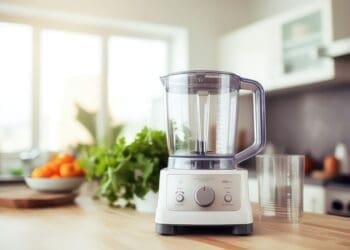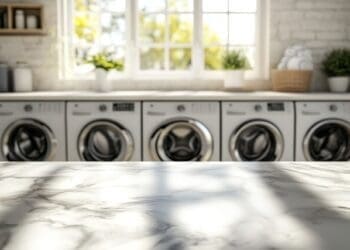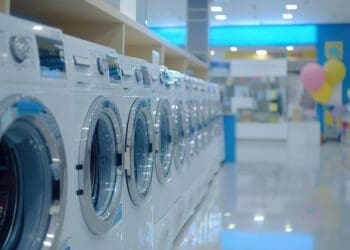Did you know that water heaters gulp down 18% of your home’s energy consumption? Your cooking and refrigeration combined don’t even use that much!
The good news is that budget-conscious homeowners can slash their energy costs. Heat pump water heaters use up to 66% less energy than conventional models. This means the average family of four saves about $550 on electricity bills each year.
A switch to an energy-efficient heat pump water heater puts over $5,600 back in your pocket throughout its lifetime. Federal tax credits of up to $2,000 make this upgrade more financially attractive than ever before.
Want to cut your energy bills while keeping those hot showers flowing? Let’s find the perfect high-efficiency water heater that fits your home’s needs.
Heat Pump Water Heaters: The New Standard in Efficiency

Image Source: Dreamstime
Heat pump water heaters represent a radical alteration in how we heat water at home. These high efficiency water heaters take heat from surrounding air and transfer it to your water tank. This approach cuts down energy use by a lot.
How heat pump technology works
Heat pump water heaters run on a simple yet clever principle – they capture existing heat instead of creating it. The system works like a refrigerator in reverse. Four key components work together in sequence:
- Evaporator: Absorbs heat from surrounding air, converting refrigerant into gas
- Compressor: Pressurizes the gas, which raises its temperature by a lot
- Condenser: Transfers heat from the hot gas to water in the tank
- Expansion Valve: Cools the refrigerant so the cycle can start again
Most models come as hybrid systems that automatically switch to standard electric resistance mode when you need more hot water. You’ll never run out of hot water, even as you save energy.
If you want to learn more about this topic or other topics…. Click here
Energy savings compared to conventional electric heaters
Heat pump water heaters’ efficiency advantage is a big deal as it means they’re three times more energy-efficient than regular electric resistance models. These units use 60-70% less energy to run.
The money you save is substantial. ENERGY STAR reports that a family of four saves about $550 each year on energy bills. Throughout its lifetime, that adds up to $5,600 in savings compared to standard electric water heaters.
On top of that, heat pump technology leaves a smaller environmental footprint. Lower electricity consumption means fewer greenhouse gas emissions, making these units perfect for homeowners who want to reduce their carbon footprint.
Ideal home situations for heat pump installation
Your heat pump water heater will work best with:
- Adequate space: You’ll need at least 700-1,000 cubic feet of air space around most models
- Consistent temperatures: The ideal setting keeps temperatures between 40°F-90°F year-round
- Proper location: These units work best in warm areas like furnace rooms
Heat pump water heaters excel in mild and moderate climates, making them a great fit for many parts of the United States. They even help dehumidify the area around them, which can make basement installations more comfortable.
The upfront cost might be higher than conventional models, but federal tax credits of up to 30% (maximum $2,000) plus local utility rebates often make these units a smart financial choice.
Tankless Water Heating: Endless Hot Water on Demand

Tankless water heaters are a smart choice for homeowners who want to save energy. These systems heat water only when you need it. You get endless hot water on demand instead of storing preheated gallons in a tank.
Gas vs. electric tankless options
Gas and electric tankless water heaters work quite differently in terms of performance and costs. Gas-powered units pump out more hot water (5-10 gallons per minute) than electric ones (2-5 gallons per minute). This makes gas units a better fit for homes where multiple people use hot water at once.
Electric tankless heaters reach 98% efficiency, while gas models top out at 80-85% efficiency. In spite of that, gas units cost more upfront ($1,000-3,000) compared to electric models ($500-800). Your local utility rates determine which type will cost less to run over time.
Space-saving benefits and installation considerations
These systems take up much less space—gas tankless models need just one-third the space of traditional tanks. You can mount them on walls to free up floor space. Some models work great outdoors too.
Each type needs specific setup requirements. Gas units must have proper ventilation and often need bigger gas lines (usually going from 1/2-inch to 1-inch). Electric models need strong electrical service, and your home might need electrical upgrades to handle their power demands.
When tankless makes financial sense
The numbers show tankless water heaters make sense financially in many cases. The Department of Energy reports these systems use 24-34% less energy than standard storage tanks, which saves about $100 yearly on energy bills.
You’ll get your money back in 12-27.5 years based on how much hot water you use. Electric models usually pay for themselves faster. These systems work best in homes that use moderate amounts of hot water and have limited space. They last 20-25 years—twice as long as regular water heaters—which means better value over time even with higher upfront costs.
Solar and Hybrid Systems for Maximum Savings

Homeowners can save substantial energy costs by combining solar power with heat pump technology. This combination creates a powerful system that reduces water heating expenses.
Solar water heater configurations
Solar water heating systems use free energy from the sun through specialized collectors that convert 60-70% of solar energy into heat. The residential market offers three main collector types: flat-plate collectors, integral collector-storage systems, and evacuated-tube collectors. Most homes use well-insulated storage tanks connected to rooftop collectors. These systems can provide up to 90% of hot water needs in summer months.
Solar systems need backup heating when it’s cloudy or when water usage increases. Conventional water heaters usually serve as backup units. They come as part of the solar package in either one-tank or two-tank setups based on what the home needs.
Hybrid heat pump systems with backup options
Heat pump water heaters blend with solar technology to create a highly efficient hybrid system. These systems offer multiple operating modes to optimize energy use. Efficient mode uses heat pump technology to maximize savings. Hybrid mode activates backup electric elements during high usage. Conventional mode runs during extreme cold, while Vacation mode cuts costs during absences.
New hybrid systems come with smart controllers that let components communicate naturally. This setup allows solar energy to reduce the heat pump’s workload and can decrease electricity consumption by 75%.
Climate considerations for renewable water heating
Climate plays a crucial role in renewable water heating performance. Evacuated tube collectors work better than flat-plate models in colder regions because their vacuum insulation reduces heat loss. Systems in freezing climates use antifreeze solutions in indirect circulation systems to prevent damage.
The amount of water heating from solar energy changes with seasons and location. It reaches 60-90% during summer and averages 60-63% yearly in northern US locations. Systems sized correctly save money even in less sunny areas because modern collectors can use diffused sunlight on cloudy days.
Installation Requirements and Home Preparation

Image Source: Logan Services
A high efficiency water heater will give a better performance, safety, and longer life when installed correctly. You’ll need to think over several requirements for your home before making a purchase.
Space and ventilation needs
Your high efficiency water heater needs enough space around it. Most manufacturers want a minimum clearance of 24 inches around the unit. This space keeps the unit safe and makes maintenance easier.
Safety rules are strict about where you can put your water heater. Bedrooms, bathrooms, and closets are off-limits because of carbon monoxide risks. Heat pump models need special attention. They need 1,000 cubic feet of air space and temperatures that stay between 40°F-90°F throughout the year.
I am glad you are enjoying this content… I have other articles related to this topic… Click Here
Gas-powered units must have good ventilation. The right venting stops dangerous carbon monoxide from flowing back into your home. You can choose between two main ventilation systems:
- Atmospheric venting: A traditional setup where exhaust naturally goes up through a chimney
- Power venting: A fan directs gasses through horizontal or vertical vents
Electrical and plumbing considerations
Different heater types have different electrical needs. Standard electric water heaters just need a 30-amp circuit breaker. But tankless electric models can need up to 120 amps. You might need to upgrade your electrical system.
Your plumbing setup should include:
- Expansion tanks on the cold water line that handle heated water expansion
- Pressure regulating valves that match your home’s water pressure
- Insulation for hot and cold water pipes that keeps heat in
DIY vs. professional installation
DIY installation might look like an affordable option at first. Professional installation is usually a better choice. Many manufacturers want professionals to install their units to keep the warranty valid. Bad installation can create serious safety issues like gas leaks, electrical problems, or explosions.
Professional plumbers know how to size things right and follow local codes. They can help with permits that different areas require. Unless you know a lot about plumbing, electrical work, and gas lines, professional installation is your safest bet. It helps you avoid expensive mistakes and gives you peace of mind.
Conclusion
Your choice of a high-efficiency water heater really affects your utility bills and environmental footprint. Heat pump water heaters offer impressive energy savings of up to 66%. Tankless systems provide endless hot water and run 24-34% more efficiently than traditional models. Solar and hybrid solutions increase these savings, especially during summer months.
The switch makes financial sense. Federal tax credits of $2,000 and annual savings of $550 for heat pump models help offset the original costs. On top of that, proper installation helps these systems deliver their promised efficiency and longevity. Professional installation proves a smart investment despite the upfront expense.
In the end, your decision depends on available space, climate, existing utilities, and budget. Modern high-efficiency water heaters provide reliable hot water and substantial long-term savings, whether you choose a heat pump, tankless, or solar hybrid system. Note that local rebates and incentives can make your upgrade more affordable.
FAQs
Q1. What are the most energy-efficient types of water heaters?
Heat pump water heaters are typically the most energy-efficient, using up to 66% less energy than conventional models. Tankless water heaters are also highly efficient, offering 24-34% energy savings compared to standard storage models. Solar water heaters can provide significant savings, especially in sunny climates.
Q2. How much can I save by switching to a high-efficiency water heater?
The average family of four can save about $550 annually on electricity bills by upgrading to an energy-efficient heat pump water heater. Over its lifetime, this can result in savings exceeding $5,600 compared to standard electric water heaters.
Q3. Are tankless water heaters a good investment?
Tankless water heaters can be a good investment for homes with moderate hot water usage and limited space. They offer endless hot water on demand and can be 24-34% more energy efficient than standard storage models. However, they have higher upfront costs and may require electrical or gas line upgrades.
Q4. What should I consider when installing a new water heater?
Consider space requirements, ventilation needs, and electrical or plumbing upgrades that may be necessary. Most water heaters need at least 24 inches of clearance around the unit. For heat pump models, ensure you have 1,000 cubic feet of air space and temperatures consistently between 40°F-90°F year-round.
Q5. Should I install a water heater myself or hire a professional?
Unless you have substantial plumbing, electrical, and possibly gas-line experience, professional installation is recommended. Many manufacturers require professional installation to maintain warranty coverage. Professionals ensure proper sizing, code compliance, and safe connections, potentially avoiding costly mistakes and safety hazards.




















































